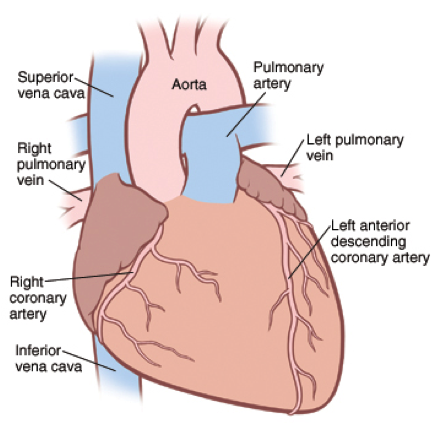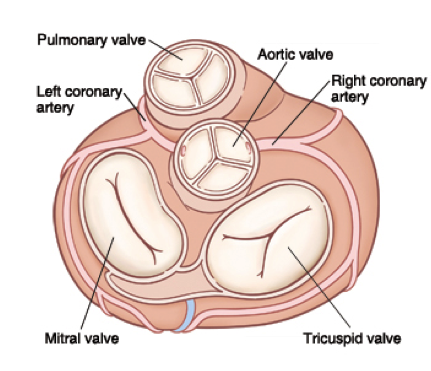Your heart pumps blood throughout your body. A heart that works well is needed for good health. It can be helpful to learn more about how the heart works to understand the best way to treat it.
Click here to access our Heart Glossary, where you can search many conditions, treatments, medications and other commonly used cardiovascular terms. If you have other questions, you can call us at 513-475-HART.
Here’s a quick overview of the basic structure of a healthy heart.

Front view of the normal heart
The heart muscle
The heart muscle contracts and relaxes to pump blood to the lungs and the rest of the body. To do its work, the heart muscle needs a constant supply of oxygen. Oxygen is supplied to the heart muscle by the coronary arteries. These are the blood vessels that wrap around the surface of the heart.
- The left main coronary artery branches into the:
- Circumflex coronary artery, which supplies blood to the back left side of the heart; and the
- Left anterior descending coronary artery, which supplies blood to the front left side of the heart.
- The right coronary artery supplies blood to the bottom, right side and back of the heart muscle.
Inside the heart

Top view of a normal heart showing the coronary arteries and four valves
The inside of the heart is divided into right and left sides. Each side has an upper chamber called the atrium and a lower chamber called the ventricle. The two upper chambers (atria) receive blood from the lungs (left atrium) and body (right atrium). When these chambers contract, blood is pumped to the two lower chambers (left and right ventricles). As the lower chambers contract, blood is pumped to the lungs from the right ventricle and to the body from the left ventricle.
- Blood carries oxygen. The right side of the heart pumps oxygen-poor blood from the body to the lungs, where it receives oxygen. The left side of the heart pumps oxygen-rich blood from the lungs to the body. Once the body’s organs and tissues have removed the oxygen from the blood, the blood returns to the heart. The cycle is then repeated.
- Valves control the flow. There are four valves inside the heart. When the heart beats, valves act like one-way doors. This keeps blood moving forward through the heart and into the body and lungs.
Parts of the heart

The heart has four valves that open and close to allow blood to flow forward through the heart
- The superior vena cava carries oxygen-poor blood from the upper part of the body to the right atrium.
- The inferior vena cava carries oxygen-poor blood from the lower part of the body to the right atrium.
- The right atrium receives oxygen-poor blood from the body through the superior vena cava and the inferior vena cava.
- The tricuspid valve allows oxygen-poor blood to flow forward from the right atrium to the right ventricle.
- The right ventricle pumps oxygen-poor blood through the pulmonary valve.
- The pulmonary valve allows oxygen-poor blood to flow forward to the pulmonary artery.
- The pulmonary artery carries oxygen-poor blood to the lungs to receive oxygen.
- The pulmonary veins carry oxygen-rich blood from the lungs to the left atrium.
- The left atrium receives oxygen-rich blood from the lungs through the pulmonary veins.
- The mitral valve allows oxygen-rich blood to flow forward from the left atrium to the left ventricle.
- The left ventricle pumps oxygen-rich blood through the aortic valve.
- The aortic valve allows oxygen-rich blood to flow forward to the aorta.
- The aorta carries oxygen-rich blood to the rest of the body, except the lungs.
.
